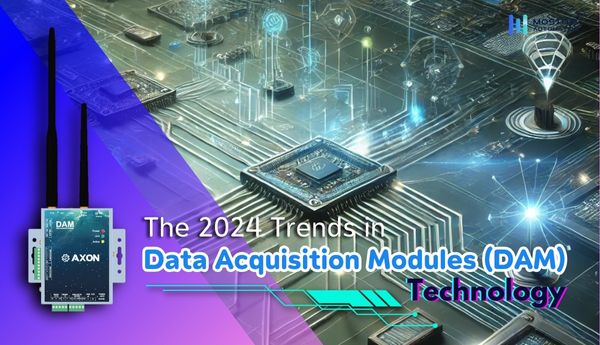The 2024 Trends in Data Acquisition Modules (DAM) Technology
Posted 29 Nov 2024 15:28 | 227 views
In 2024, Data Acquisition Modules (DAM) technology has evolved significantly to meet the growing demands across various industries that require precise, real-time data analysis. DAM Gateway play a critical role in gathering data from sensors and other devices, supporting strategic decision-making in industrial and IoT applications. With new technological advancements, DAM Gateway have become crucial for industries aiming to embrace smart manufacturing and IoT in 2024. Below are the major technology trends shaping DAM Gateway technology this year.
1. Wireless Connectivity and IoT
Wireless connectivity is a key trend in modern DAM Gateway technology. Modules that support wireless protocols like Wi-Fi, Bluetooth, and LoRaWAN have become essential in industrial environments and IoT networks. This allows DAMs to efficiently collect data from sensors over wide distances without relying on cables. It significantly reduces setup costs and offers flexibility for real-time data acquisition. Wireless connectivity also enables DDAM Gateway to operate effectively in challenging environments such as underground pipelines, large industrial plants, and outdoor locations.
2. Edge Computing and AI Integration
Edge Computing allows data processing to occur near the data source, minimizing the need to send data to central servers. This reduces latency and enables DAM Gateway to provide real-time insights. Integrating AI further enhances DAM Gateway capabilities by allowing real-time analysis and anomaly detection at the edge. For example, AI can identify patterns and detect abnormal data, enabling fast and accurate system monitoring. This helps organizations make effective decisions even in areas with limited internet connectivity
3. Support for Multiple Industrial Protocols
Modern DAM Gateway are developed to support a wide range of industrial protocols like Modbus, OPC-UA, and MQTT. These protocols enable DAM Gateway to connect seamlessly with automation systems and SCADA networks, simplifying data integration from diverse systems. The support for multiple protocols enhances interoperability, streamlining data collection, and reducing the complexity and cost associated with integrating additional systems for comprehensive data analysis.
4. Onboard Data Storage and Analytics
New DAM models come equipped with onboard memory and processing capabilities, enabling preliminary data analysis. This means that DAM Gateway not only collect data but can also process it immediately, calculating averages or monitoring data fluctuations. Organizations can gain immediate insights, reducing the burden on central processing systems. This feature accelerates data analytics, allowing quicker response times and better decision-making.
5. High Precision and Multi-Functionality
DAM Gateway have become more versatile with their ability to handle data from various sensor types, such as electrical signals, temperature, vibration, and more. High-precision data acquisition allows for more detailed analytics and more accurate insights, making DAM Gateway ideal for industries requiring detailed, reliable data to drive efficient operations.
6. Enhanced Data Security and Cybersecurity
With the rise of cyber threats, data security in DAM Gateway has become paramount. Advanced cybersecurity features ensure that the data gathered from sensors remains secure and protected from unauthorized access. Cybersecurity technologies, such as data encryption, user access control, and suspicious behavior detection, help safeguard DAM Gateway against potential cyber attacks. This security focus ensures that data collected and analyzed within the DAM Gateway environment remains secure and private throughout its lifecycle.
With these advancements, Data Acquisition Modules are increasingly essential for organizations seeking to accelerate digital transformation securely and efficiently. DAM Gateway empower industries to meet the demands of the digital era, enabling better data utilization, rapid decision-making, and secure operations as industries continue to expand.

